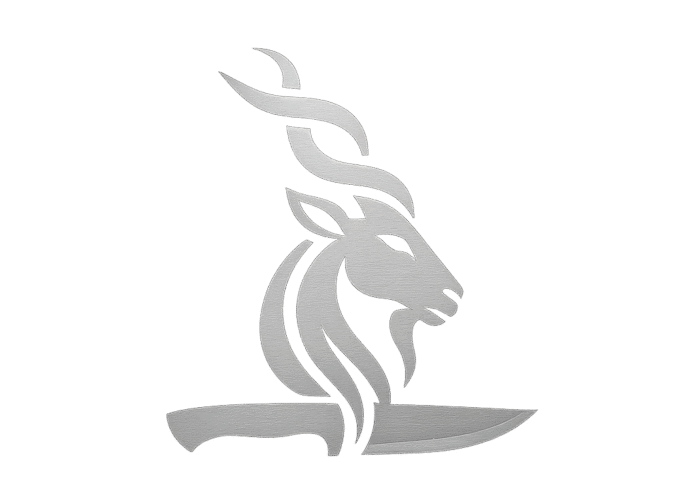Fellow knife enthusiasts! If you’re anything like me, there’s something undeniably captivating about a well-crafted knife. It’s not just a tool—it’s a piece of history, a work of art, and sometimes even a lifesaver in the great outdoors. At Markhor Knives, we’ve dedicated ourselves to crafting premium blades that blend tradition with modern innovation. Whether you’re a hunter, a collector, or just someone who appreciates fine craftsmanship, this guide is for you.
In this ultimate knife guide, we’ll dive deep into some of the most iconic knife types we specialize in: the legendary Bowie knife, the fierce Kukri knife, versatile hunting knives, stunning Damascus knives, tactical Karambit knives, precise skinning knives, and rugged tracker knives. I’ll share their fascinating histories, various types, practical uses, and tips on why they might be the perfect addition to your collection. We’ll also cover how to choose the right knife, care for it, and even touch on legal stuff to keep you on the safe side.
By the end, you’ll feel like a knife expert—and hopefully inspired to check out our handcrafted selections at Markhor Knives. Let’s sharpen our knowledge and get started!
1. Bowie Knife: The Iconic American Legend
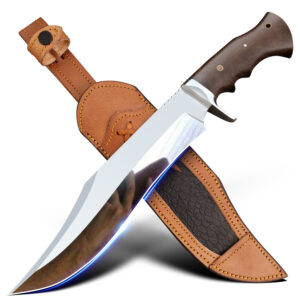
Ah, the Bowie knife—where do I even begin? This blade has been romanticized in stories, movies, and folklore for nearly two centuries. Named after James “Jim” Bowie, the frontiersman who wielded it during the infamous Sandbar Fight in 1827 near Natchez, Mississippi, the Bowie knife quickly became a symbol of American grit and self-reliance.
A Brief History
The origins trace back to the early 19th century when Rezin Bowie (Jim’s brother) designed a large, fixed-blade knife for fighting and survival. After the Sandbar Fight—where Jim Bowie survived a brutal brawl despite being shot and stabbed—the knife’s reputation exploded. It played a role in the Texas Revolution, including the Alamo in 1836, and was used by Texans to dig through walls during the Siege of Bexar. By the mid-1800s, Bowie knives were mass-produced in England and America, evolving from simple fighting tools to ornate status symbols.
Types of Bowie Knives
Bowie knives come in various styles, but they all share that signature clip-point blade (curved at the tip for piercing) and a sturdy crossguard to protect your hand.
- Classic Bowie: Large (8-12 inches), with a straight back and sharp clip point—perfect for the original fighting purpose.
- Hunting Bowie: Slightly smaller, with a drop-point for better control during skinning or field dressing.
- Custom Bowie: Often handmade with exotic handles (like bone or wood) and decorative elements, blending functionality with art.
- Modern Tactical Bowie: Updated with high-carbon steel for durability, sometimes featuring serrated edges for utility.
Uses and Why It’s Still Relevant
Originally a fighting knife, the Bowie has adapted beautifully to modern needs. Hunters love it for field dressing game, campers use it for chopping wood or self-defense, and collectors prize its historical vibe. In the wilderness, its size and sharpness make it ideal for everything from slicing rope to preparing food. At Markhor Knives, our Bowie knives are forged with premium steel for that perfect balance of edge retention and toughness—whether you’re recreating Wild West adventures or just need a reliable tool.
If you’re new to Bowies, start with a mid-sized one; it’s versatile enough for everyday carry (where legal) without feeling overwhelming.
2. Kukri Knife: The Gurkha’s Timeless Companion

Switching gears to something exotic—the Kukri knife (or Khukuri) is a curved powerhouse that’s as much a cultural icon as it is a tool. Originating from Nepal, this blade has been wielded by Gurkha warriors for centuries, earning a fearsome reputation on battlefields worldwide.
A Brief History
The Kukri’s roots go back to the 16th century, linked to the Gorkhali Sainik under King Prithivi Narayan Shah. Some believe it evolved from ancient Greek kopis swords brought by Alexander the Great’s army, but it’s most famously associated with Nepalese Gurkhas, who used it in World War I and II. The British were so impressed by the Gurkhas’ skill that they recruited them—and the Kukri became their national weapon. Today, it’s still issued to Gurkha soldiers and symbolizes bravery in Nepal.
Types of Kukri Knives
Kukris vary in size and design, but all feature that distinctive inward curve for chopping power.
- Traditional Kukri: 10-15 inches, with a notched spine (cho) for religious significance—often handmade in Nepal.
- Military Sirupate: Slim and long (up to 19 inches), issued to soldiers for combat and utility.
- Budhume: A heavy, broad blade (20th century style) for chopping wood or heavy tasks.
- Survival Kukri: Modern versions with ergonomic handles and sheaths including tools like sharpeners.
- Decorative Kukri: Ornate with engraved blades, used for ceremonies or display.
Uses and Why It’s Still Relevant
The Kukri’s curve makes it a beast for chopping—think clearing brush, cutting firewood, or even butchering meat. In combat, it’s deadly for slashing, and Gurkhas have used it for everything from digging trenches to signaling. For hunters and campers, it’s a multi-tool: chop, slice, or even use the spine for scraping. Our Kukri knives at Markhor Knives are crafted with authentic designs but modern materials for superior performance—ideal if you’re heading into the backcountry or just want a piece of warrior history.
Pro tip: The notch at the base? It’s not just decorative; it prevents blood from dripping onto the handle during use.
3. Hunting Knife: The Essential Outdoor Companion
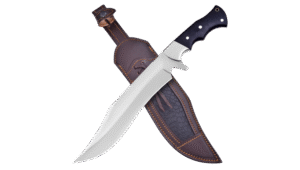
No knife guide would be complete without the hunting knife—the workhorse of the wilderness. These blades have been around since the Stone Age, evolving from primitive tools to sophisticated gear for modern sportsmen.
A Brief History
Early humans fashioned hunting knives from flint and bone for skinning and butchering. Ancient Egyptians used bronze versions, while the Romans had specialized gut-hook designs. By the 17th century in Europe, hunting knives became status symbols with ornate hilts. In America, they exploded in popularity during the frontier era, with figures like Daniel Boone relying on them. Today, they’re regulated but essential for ethical hunting.
Types of Hunting Knives
Hunting knives prioritize sharpness and control, with blades typically 3-6 inches.
- Fixed-Blade Hunting Knife: Sturdy for heavy tasks like field dressing; no moving parts.
- Folding Hunting Knife: Compact for pocket carry, great for quick tasks.
- Drop-Point Hunting Knife: Rounded tip for precision skinning without piercing organs.
- Clip-Point Hunting Knife: Pointy for piercing, versatile for general use.
- Gut-Hook Hunting Knife: Features a hook for clean, zipper-like skinning.
Uses and Why It’s Still Relevant
Primarily for preparing game—skinning, gutting, and quartering—the hunting knife also shines in camping (cutting rope, preparing food) or survival scenarios. Its design minimizes meat waste, making it ethical for hunters. At Markhor Knives, our hunting knives are built with high-carbon steel for razor-sharp edges that hold up in the field. If you’re a beginner hunter, go for a drop-point; it’s forgiving and multi-purpose.
Remember, a good hunting knife isn’t just about the blade—pair it with a sharpener for longevity.
4. Damascus Knife: Beauty Meets Strength
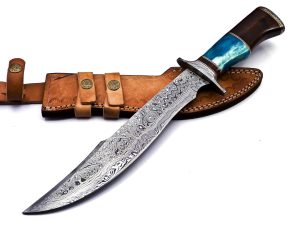 Damascus knives aren’t just tools; they’re masterpieces with swirling patterns that scream craftsmanship. Their allure comes from ancient forging techniques that create blades as tough as they are stunning.
Damascus knives aren’t just tools; they’re masterpieces with swirling patterns that scream craftsmanship. Their allure comes from ancient forging techniques that create blades as tough as they are stunning.
A Brief History
True Damascus steel originated in the Near East around 300 BC, famous for its wavy patterns and superior strength—used in swords that could cut through armor. The secret was lost by the 18th century, but modern “Damascus” refers to pattern-welded steel, folding layers of metal for that signature look. It gained popularity in India (Golconda) and Sri Lanka, and today, it’s revived for knives worldwide.
Types of Damascus Knives
The patterns vary based on folding techniques, but all are layered for durability.
- Twist Damascus: Twisted layers for a starburst pattern, common in hunting knives.
- Ladder Damascus: Folded and ground for ladder-like lines, elegant for pocket knives.
- Mosaic Damascus: Complex designs like flowers, often in custom pieces.
- Raindrop Damascus: Droplet patterns, popular for chef or utility knives.
- Wootz Damascus: Rare recreation of ancient steel, ultra-sharp but pricey.
Uses and Why It’s Still Relevant
Damascus knives excel in cutting tasks where edge retention matters—hunting, cooking, or everyday carry. The layered steel resists chipping, and the patterns make them collector’s items. Our Damascus knives at Markhor Knives use high-quality layers for both beauty and bite. Care tip: Avoid dishwashers; hand-wash to preserve the pattern.
If you’re a collector, start with a Damascus hunting knife—it’s functional art.
5. Karambit Knife: The Claw of the Tiger
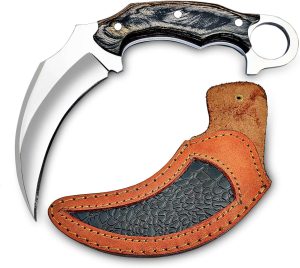
The Karambit knife looks like it jumped straight out of a martial arts movie, with its curved blade and finger ring. It’s a tactical favorite with roots in Southeast Asia.
A Brief History
Originating in Indonesia around the 11th century, the Karambit started as a farming tool (inspired by a tiger’s claw) for harvesting rice. It evolved into a self-defense weapon in Malaysia and the Philippines, used in silat martial arts. Traders spread it across Asia, and today, it’s popular in modern tactical training and video games like Counter-Strike.
Types of Karambit Knives
All feature a curved blade (2-3 inches) and ring handle for grip.
- Traditional Karambit: Fixed blade, wooden handle—authentic for cultural use.
- Folding Karambit: Compact for EDC, with locking mechanisms.
- Tactical Karambit: Serrated edges, synthetic handles for military/police.
- Training Karambit: Blunt for safe practice in martial arts.
- Custom Karambit: Engraved or with exotic materials for collectors.
Uses and Why It’s Still Relevant
In self-defense, the curve allows ripping and hooking motions; for utility, it’s great for cutting rope or packages. Martial artists swear by it for close-quarters combat. At Markhor Knives, our Karambit knives are designed for ergonomic comfort and razor sharpness—perfect for training or protection. Warning: Check local laws; some places restrict curved blades.
Practice with a trainer first—it’s a unique grip!
6. Skinning Knife: Precision for the Hunt
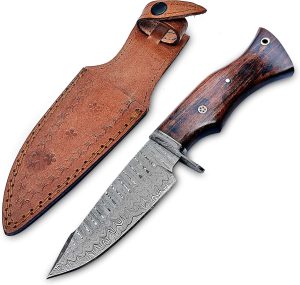
The skinning knife is a hunter’s best friend, designed for clean, efficient work after the shot. It’s all about that curve and sharpness.
A Brief History
Dating back to the Stone Age, early skinning tools were made from flint for separating hide from meat. Ancient Egyptians and Romans refined them with bronze, and by the 17th century, European hunters had specialized versions. In America, they became essential during the fur trade era, evolving with steel advancements.
Types of Skinning Knives
Short blades (3-5 inches) with upswept tips to avoid puncturing hides.
- Curved Skinning Knife: Classic upswept blade for smooth cuts.
- Gut-Hook Skinning Knife: Hook for zipping open hides without damage.
- Fixed-Blade Skinner: Durable for field use.
- Folding Skinner: Portable, with replaceable blades.
- Damascus Skinner: Patterned steel for style and strength.
Uses and Why It’s Still Relevant
Primarily for removing animal skins without tearing meat—ideal for deer, elk, or small game. It’s also handy for fishing (filleting) or camping (prepping food). Our skinning knives at Markhor Knives feature ergonomic handles to reduce hand fatigue during long sessions. For ethical hunting, a sharp skinner minimizes waste.
Sharpen regularly; a dull blade ruins good hides.
7. Tracker Knife: The All-Purpose Survival Beast
![]()
Last but not least, the tracker knife—a modern survival icon designed for versatility in the wild. It’s like having multiple tools in one blade.
A Brief History
Invented by wilderness expert Tom Brown Jr. in the late 20th century, the tracker knife was inspired by Native American designs and his survival teachings. It gained fame through movies like “The Hunted” (2003) and has evolved from Brown’s original prototype into various custom versions. Its genesis came from an interview where Brown described the perfect all-in-one knife.
Types of Tracker Knives
Large (8-10 inches) with a unique shape: curved edge, sawback, and chisel tip.
- Classic Tracker: Tom Brown’s design with a drop-point and saw spine.
- Survival Tracker: Added features like a hammer pommel or fire starter.
- Custom Tracker: Hand-forged with exotic handles for personalization.
- Compact Tracker: Smaller for EDC, retaining multi-tool functions.
- Tactical Tracker: Military-grade steel for extreme durability.
Uses and Why It’s Still Relevant
This knife does it all: chop wood, saw branches, scrape hides, dig, or even hammer. In survival situations, it’s invaluable for building shelters or preparing food. Hunters use it for tracking and field dressing. At Markhor Knives, our tracker knives are built to Brown’s specs but with premium materials for reliability. It’s a must-have for bushcraft enthusiasts.
Test it in a controlled environment first—it’s powerful!
How to Choose the Right Knife for You
With so many options, picking the perfect knife boils down to your needs:
- Purpose: Hunting? Go for a skinning or hunting knife. Survival? Tracker or Kukri. Self-defense? Karambit or Bowie.
- Blade Material: High-carbon steel for sharpness, stainless for rust resistance, Damascus for beauty.
- Handle: Ergonomic and non-slip—wood for tradition, synthetic for grip in wet conditions.
- Size and Weight: Larger for heavy tasks, compact for carry.
- Budget: Start affordable, but invest in quality for longevity.
At Markhor Knives, we offer customization to match your style—reach out for advice!
Knife Care and Maintenance: Keeping Your Blade Sharp
A great knife lasts a lifetime with proper care:
- Cleaning: Wipe after use, hand-wash with mild soap—avoid dishwashers.
- Sharpening: Use a whetstone or honing rod regularly; angle at 20 degrees.
- Storage: Sheath it to prevent damage; oil the blade to avoid rust.
- Legal Tips: Check local laws—some knives (like Bowies or Karambits) are restricted in certain areas.
Why Choose Markhor Knives?
We’re not just sellers; we’re passionate craftsmen. Each knife is hand-forged with attention to detail, using top-grade materials. Whether you’re after a classic Bowie or a modern tracker, our blades are built to perform and last. Browse our collections today and elevate your gear!
Ready to find your perfect knife? Explore our full range or contact us for custom orders. Happy adventuring—and stay sharp!
Disclaimer: Always use knives responsibly and legally. This guide is for informational purposes.


